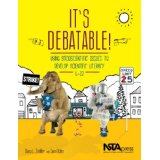It's Debatable! Using Socioscientific Issues to Develop Scientific Literacy
By Carole Hayward
Posted on 2014-03-13
“Should schools charge more money for ‘unhealthy’ foods?” “Should animals perform in circuses?” Should rare Earth elements be mined in the United States?” “Should prescription drugs be advertised directly to consumers?”
 In It’s Debatable! Using Socioscientific Issues to Develop Scientific Literacy, authors Dana L. Zeidler and Sami Kahn present a persuasive case for connecting science lessons to real-world questions and issues like these. Seven classroom units give students practice in the research, analysis, and argumentation necessary to grapple with difficult questions and build scientific literacy.
In It’s Debatable! Using Socioscientific Issues to Develop Scientific Literacy, authors Dana L. Zeidler and Sami Kahn present a persuasive case for connecting science lessons to real-world questions and issues like these. Seven classroom units give students practice in the research, analysis, and argumentation necessary to grapple with difficult questions and build scientific literacy.
Today’s students need to be “science literate” in order to contend with these issues, but what exactly does that mean? More than simply knowing the content included in our science standards, our students need to be able to synthesize, analyze, and deliberate over complex socioscientific issues (SSI) which will demand their attention, their input, and perhaps, their vote.
As the authors explain, “As science educators, we do not have a choice but to move our curricula into a new era of contextualized science; our students want to have a say in local and global issues and with their unbridled access to information, they need to be able to identify the positions and motivations of various stakeholders. They also need to be well versed in analyzing the quality of information they receive, including the difference between science and pseudoscience.”
Constructing an SSI unit may seem daunting at first, but the authors suggest that teachers start by adding SSI lessons to already-existing units. For example, if you are doing a unit on the human body, consider incorporating research on a related controversial issue such as, “Should fluoride be added to drinking water?” or “Should fried foods be banned?”
To help facilitate the process, the authors have identified some steps that are useful in guiding teachers through the development and implementation of SSI in their classrooms:
- Identify Topics. Review newspapers, books, internet sources, professional science education-related journals, and television/movies for current issues related to your subject matter and course objectives.
- Collect Resources. Look for a range of sources reflecting a diversity of viewpoints.
- Introduce Topic. Engage students with magazine headlines, articles, advertisements, YouTube videos, photos, models, or other media.
- Prepare Students for Discussions. Set ground rules for class discussions, emphasizing the value of all ideas, mutual respect for participants, and intolerance for mockery or personal attacks.
- Pose Controversial Questions. Introduce contentious questions (e.g., “Should schools charge a ‘fat tax’ for unhealthy foods?”) and challenge “common knowledge” of subject matter (e.g., Are calories from fat different than calories from sugar?”).
- Provide Formal Instruction. Present subject matter in a variety of ways (e.g., direct teaching, laboratory investigations, internet/textbook research, class discussions, guest speakers, field trips, films) to ensure content coverage and student engagement.
- Incorporate Group Activities. Allow students to investigate issues in small groups, emphasizing the analysis of evidence, reinforcement of content matter, monitoring of understanding, consideration of divergent viewpoints, and full participation of all students.
- Provide Guidance in Evaluating Primary and Secondary Sources. Discuss the importance of identifying bias and provide tools for assessing trustworthiness of research sources.
- Assess Knowledge and Reasoning. A variety of “products” that allow students to demonstrate learning can be developed. Assessment should include content understanding as well as its reasoned applications to the issue at hand.
- Have fun! SSI provides opportunities for creativity, engagement, and exploration by students and teachers.
To get a sense of how each lesson in the book is presented and organized, check out the sample chapter: A Need for Speed? Should speed limits be lowered to reduce traffic fatalities? This book is also available an e-book.
Disclaimer: The views expressed in this blog post are those of the author(s) and do not necessarily reflect the official position of the National Science Teaching Association (NSTA).


